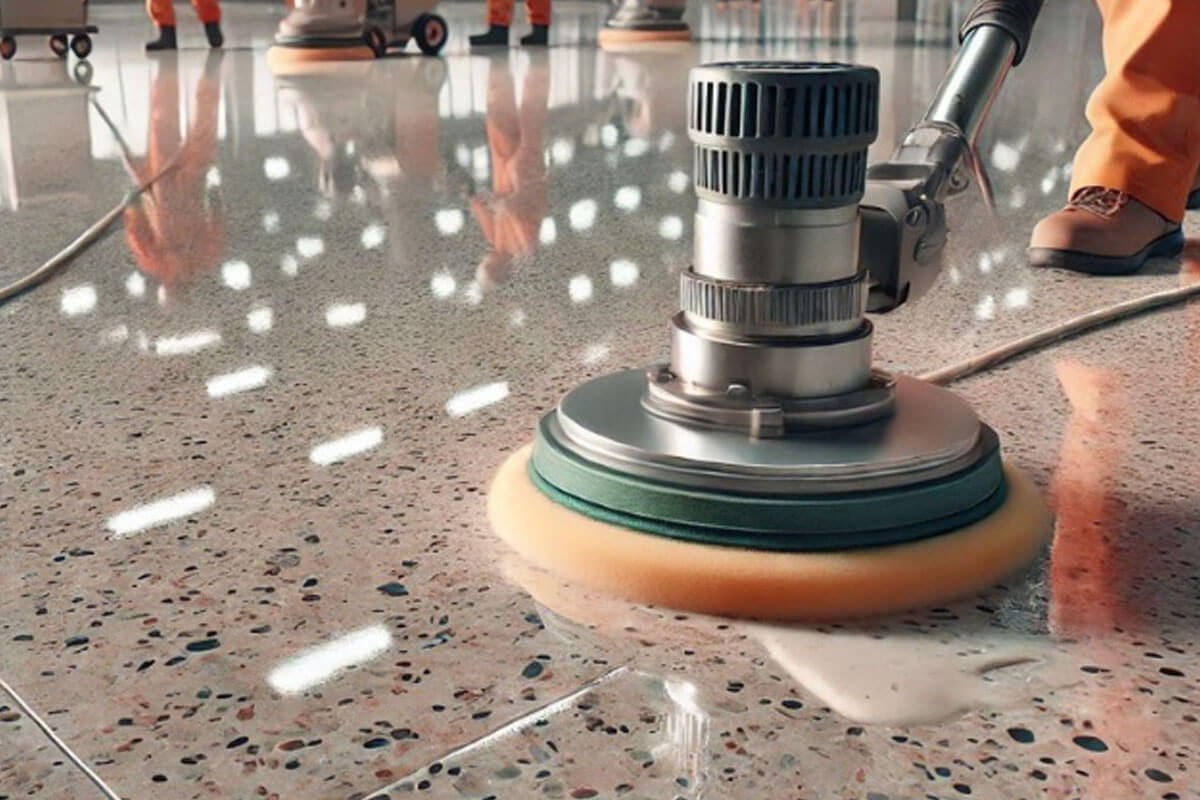How to clean terrazzo floors starts with regular dust mopping and weekly damp mopping using a neutral pH cleaner. You need to avoid acidic or alkaline products that can etch the surface. The key is gentle cleaning with the right tools and products. This guide shows you exactly how to preserve your terrazzo looking its best for decades.
- Understanding Terrazzo Types and Why It Matters
- Daily & Weekly Maintenance Best Practices
- Dealing with Stains, Scratches & Damage
- Choosing Tools, Cleaners & Sealers
- Resurfacing vs Regular Maintenance
- Troubleshooting Mistakes & Common Problems
- Protecting Your Investment Long-Term
- Key Takeaways for Cleaning Terrazzo Floors:
Understanding Terrazzo Types and Why It Matters
Your terrazzo type determines which cleaning methods work best. Two main types exist: cementitious terrazzo (traditional cement-based) and epoxy terrazzo (modern resin-based).
Cementitious terrazzo is more porous and vulnerable to stains. It needs careful sealing and cannot handle harsh chemicals or excessive moisture. This type scratches more easily, so you must use soft tools and gentle cleaners. Epoxy terrazzo is non-porous and more stain-resistant. It handles moisture better and requires less intensive terrazzo maintenance. You can use slightly more aggressive surface cleaning on epoxy, but you still need to avoid acidic or alkaline products. Both types share marble chips or stone chips embedded in the surface, which means acids will etch and damage them.
Knowing your floor type helps you choose the right floor sealing approach. Cement-based floors need penetrating sealers that soak into the porous surface. Epoxy floors work well with topical sealers that create a protective layer on top. The word “terrazzo” comes from the Italian word for “terrace,” reflecting its original outdoor use. Check with your installer or a professional to confirm which type you have before starting any deep cleaning or restoration work.
How to Tell Which Type You Have
Look at the installation thickness and location. Cement terrazzo is usually thicker (over 2 inches) and found in older buildings. Epoxy terrazzo can be as thin as 1/4 inch and appears in modern installations. You can also perform a simple water test patch: drop water on an inconspicuous spot. If it beads up quickly, you likely have sealed epoxy. If it absorbs slowly, you probably have cement-based terrazzo.
Daily & Weekly Maintenance Best Practices
Start every day with a daily dust mop to remove grit and dirt. This simple step prevents scratches and keeps your floor looking clean. Use a microfiber dust mop for better dirt capture.
Dust mopping takes just a few minutes but protects your investment. Grit acts like sandpaper under foot traffic, wearing down the surface over time. Choose the largest mop head that fits your space to work faster. Keep the mop on the floor surface at all times. Lifting it releases trapped dirt back into the air. Never use oil-based sweeping compounds because they penetrate terrazzo and cause permanent stains. Microfiber dust mops provide increased cleaning efficacy over traditional dust mops by trapping and containing more soils and contaminants.
Weekly cleaning requires damp mopping with warm water and a neutral pH cleaner. Mix the cleaner with a pH factor between 7 and 10 according to the manufacturer’s directions. Pre-wet the floor with clean water before mopping. This helps the cleaning solution work better and prevents streaks. Let the solution sit for several minutes to loosen dirt, but do not let it dry on the surface. Mop up all residue with clean water before the floor dries.
For lightly soiled areas, one weekly mopping is enough. High-traffic zones may need cleaning twice per week or more. After mopping, you can buff the dry floor with a dry brush to restore the shine. This simple step brings back the natural luster without adding chemicals or waxes. Clean thoroughly your mop and bucket after each use to prevent spreading old dirt during the next cleaning session.
Dealing with Stains, Scratches & Damage
Spot-clean stubborn stains immediately with a neutral pH cleaner diluted in warm water. Address spills as soon as they happen to prevent permanent damage to this durable composite material.
For oil-based stains, you may need a stain removal poultice. Mix baking soda with water to form a thick paste. Apply it directly to the stain and let it sit for 30 minutes to several hours. The paste draws out the oil as it dries. Scrape away the dried paste and rinse with clean water. Repeat if needed until the stain disappears. Organic stains from coffee, wine, or food respond well to hydrogen peroxide. Apply it to the stain, let it sit briefly, then wipe clean. Always test any method on a hidden area first to check for adverse reactions.
Rust stains require professional help because home remedies can make them worse. Never use acidic cleaners or citrus-based products on terrazzo. They will etch the marble chips and create dull spots that cannot be easily repaired. For scratches and dull zones, light buffing with a low speed buffer and fine abrasive pad polishing can help. Start with the least aggressive pad and work up only if needed. Deep scratches may require professional grinding and polishing to smooth the surface.
Scuff marks often come off with mild agitation using a white or pink buffing pad. Attach the pad to a floor machine and work in small circular motions. If the scuff remains after cleaning, it may be embedded in the sealer rather than the terrazzo itself. In this case, you might need to strip and reseal that section.
Choosing Tools, Cleaners & Sealers
Always select pH-neutral cleaners designed for natural stone or terrazzo. Check the product label to confirm it is safe for marble and stone surfaces.
Avoid all-purpose cleaners, bleach, ammonia, vinegar, and citrus-based products. These contain acids or alkalis that damage terrazzo permanently. Read ingredient lists carefully. Even products marketed as “natural” can contain harmful acids. A good neutral pH cleaner will state a pH between 7 and 10. Mix it with warm water according to the label. Using too much cleaner wastes product and leaves residue that dulls the finish.
Modern robotic floor cleaner devices work well for daily upkeep on terrazzo. Models from brands like Roborock, Eufy, and Dyson can handle both vacuuming and mopping. Set them to use gentle mopping modes with plain water or a light neutral cleaner solution. Steam cleaners use hot steam to effectively kill bacteria and other germs, making them a great option for sanitizing terrazzo floors. However, avoid using steam cleaners on cement-based terrazzo because excessive heat and moisture can damage the porous surface. Epoxy terrazzo tolerates steam better, but you should still use caution. Move the steam cleaner continuously and never let it sit in one spot for more than a few seconds.
For sealing, choose between penetrating and topical sealers. A penetrating sealer soaks into the terrazzo and protects from within. This type works best for cement-based floors and maintains a natural look. Topical sealers sit on the surface and create a protective coating. They offer a higher gloss and more scratch-resistant finish. Water-based sealers are most commonly recommended and utilized today. Apply sealer according to the manufacturer’s instructions, usually in one or more thin coats. Some installations use a combination: penetrating sealer first, then a topical finish for added gloss retention.
Resurfacing vs Regular Maintenance
Regular cleaning and sealing can maintain terrazzo for years, but eventually you may need professional resurfacing. Signs include widespread dullness, deep scratches, or severe staining that cleaning cannot remove.
Resurfacing terrazzo involves grinding down the surface to expose fresh material underneath. Professionals use diamond grinding pads in progressively finer grits. Coarse pads remove damage and level the surface. Fine pads polish it to a smooth, glossy finish. This process can remove scratches, stains, and years of wear. After grinding and polishing, the floor gets sealed again to protect the newly exposed surface. The entire process takes several days depending on the area size.
Decide between daily upkeep and full restoration based on your floor’s condition and your budget. If your terrazzo looks generally good with only minor issues, stick with regular flooring maintenance. Clean properly, reseal every few years, and address problems as they appear. This approach costs less and extends the time before resurfacing becomes necessary. If your floor has widespread damage, dullness, or heavy staining, resurfacing makes sense. The cost is higher upfront but gives you essentially a new floor. Professional terrazzo contractors can assess your situation and provide estimates.
Timing matters for resurfacing. Plan it during low-traffic periods or building closures. The work creates dust and requires the area to be empty. Always hire experienced terrazzo professionals for this work. DIY grinding can easily damage the floor beyond repair if done incorrectly. Ask for references and examples of previous work before hiring anyone.
Troubleshooting Mistakes & Common Problems
Cloudy or hazy finishes usually come from cleaner residue or improper sealer application. Strip the old sealer and start fresh if the problem persists.
Watermarks and streaks happen when you let cleaning solution dry on the surface. Always rinse thoroughly with clean water after mopping. Pick up all moisture with a clean mop or squeegee. If watermarks remain after the floor dries, rewash that section and dry it completely. Hard water can leave mineral deposits that look like white spots or streaks. If you have hard water, use distilled water for the final rinse or add a small amount of vinegar to the rinse water (only for the rinse, never for cleaning the terrazzo directly).
Uneven gloss or patchy surfaces suggest inconsistent sealer coverage. Some areas may have absorbed more sealer than others, especially on cement-based terrazzo. You can apply another thin coat of sealer to even things out. Buff the surface after it dries to blend any differences. If the patches look like stains rather than finish issues, you may have actual discoloration from spills or dirt penetration. In this case, you need to clean thoroughly or use a poultice treatment.
When your methods fail despite following all the rules, call a professional. Some problems run too deep for DIY solutions. Etching from acid exposure, severe staining, and structural damage require expert tools and knowledge. Do not try aggressive chemical strippers or harsh abrasives yourself. You will likely make the damage worse. Professional terrazzo contractors have specialized equipment and products not available to homeowners. They can assess the true condition of your flooring system and recommend the most cost-effective solution. Ignoring problems or using wrong methods leads to neglect that compounds over time.
Protecting Your Investment Long-Term
Keeping your terrazzo in pristine condition requires consistent proper care beyond basic cleaning. Entry mats play a critical role in floor care success.
A three-stage matting system should be implemented: exterior scraper mats to remove large debris, vestibule mats to remove moisture and smaller particles, and interior walk-off mats extending 10 to 15 feet from the entrance. This system stops dirt before it reaches your terrazzo. Clean these mats regularly so they continue working effectively. Replace worn mats promptly to maintain protection.
Commercial facilities should evaluate gloss levels on terrazzo with a glossmeter, typically maintained between 40-60 gloss units. For residential spaces, visual inspection works fine. Check your floor every few months for dull spots, new scratches, or areas where the sealer seems worn. Early detection prevents small issues from becoming expensive repairs. Keep records of when you last sealed the floor and what products you used. This information helps you maintain a consistent care schedule.
Allowing spills to dry can stain aggregates and discolor wax or sealers, leading to costly repairs. Train everyone in your household or facility to wipe up spills immediately. Keep pH-neutral cleaner and microfiber cloths in convenient locations for quick response. The faster you address spills, the less likely they are to cause permanent damage to your beautiful aggregate-embedded flooring.
Key Takeaways for Cleaning Terrazzo Floors:
Your terrazzo floor will last for decades when you follow these essential practices:
1. Know your terrazzo type (cement-based or epoxy) before choosing cleaning products and methods.
2. Use only neutral pH cleaners rated between 7 and 10 to avoid etching the marble and stone chips.
3. Dust mop daily to remove grit that scratches the surface under foot traffic.
4. Address stains immediately with appropriate treatments based on the stain type (oil, organic, rust).
5. Reseal periodically to maintain protection and restore the shine, choosing penetrating or topical sealers based on your floor type.
Following these guidelines keeps your terrazzo looking beautiful while protecting your investment. Regular gentle surface care prevents the need for expensive restoration work down the line.





